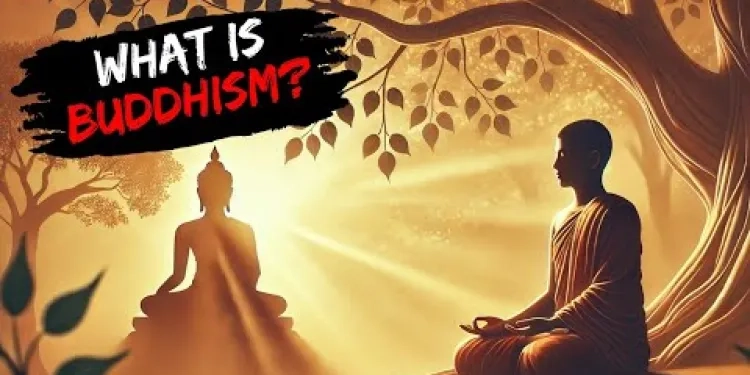Find Help
More Items From Ergsy search
-

What Is Buddhism? A Beginner’s Guide to Buddhist Beliefs
Relevance: 100%
-

Can my religion exempt me from jury service?
Relevance: 11%
-

The history of the Baptist Church and Anabaptist: The Good The Bad and the Ugly
Relevance: 10%
-

Sikhism Explained
Relevance: 10%
-

Origin of Judaism - A Brief History | 5 MINUTES
Relevance: 9%
-

Can certain medical conditions prevent receiving blood transfusions?
Relevance: 9%
-

What role does stigma play in the HIV epidemic?
Relevance: 8%
-

Can I practice my religion?
Relevance: 8%
-

What is a Humanist Celebrant
Relevance: 8%
-

How Did Catholicism Start?
Relevance: 7%
-

A History of The Church of England
Relevance: 7%
-

What is direct cremation and how much does it cost in the UK?
Relevance: 6%
-

Redundancy Coaching Couch 1: Redundancy and Presuppositions
Relevance: 6%
-

Are vaccines linked to autism?
Relevance: 6%
-

John Wesley: Faith That Sparked the Methodist Movement | Full Movie
Relevance: 6%
-

How is dishonesty determined in a legal context?
Relevance: 5%
-

Is it necessary to stop conventional treatment when starting homeopathy?
Relevance: 5%
-

What happens to unused embryos?
Relevance: 5%
-

How can honour based abuse be prevented?
Relevance: 5%
-

What is the role of a juror?
Relevance: 4%
-

Can men be perpetrators of honour based abuse?
Relevance: 4%
-

New Study Reveals Surprising Facts About Daily Step Counts
Relevance: 4%
-

What are the different methods of burial available in the uk?
Relevance: 4%
-

Planning for your funeral
Relevance: 4%
-

Is it safe to sleep after a concussion?
Relevance: 4%
-

Is it safe to sleep after a concussion?
Relevance: 4%
-

The True History of the Catholic Church That No One Told You
Relevance: 4%
-

Can cold weather cause a cold?
Relevance: 4%
-

Are there any scientific studies supporting homeopathy?
Relevance: 4%
-

Which countries have higher rates of measles?
Relevance: 4%
-

What should I do if I find a spider in my home?
Relevance: 4%
-

Stammering myth 4: You should ignore a child's stammer
Relevance: 4%
-

Planning Your Funeral in Advance? | Expert Tips from Celebrants
Relevance: 4%
-

What is CBT
Relevance: 4%
-

Can you get chickenpox more than once?
Relevance: 4%
-

Can nits survive on furniture or clothing?
Relevance: 4%
-

How do you spot delirium
Relevance: 4%
-

How does homeopathy differ from conventional medicine?
Relevance: 4%
-

Can the flu vaccine give me the flu?
Relevance: 4%
-

What happens if I have special dietary needs?
Relevance: 4%
What Is Buddhism? A Beginner’s Guide to Buddhist Beliefs
Buddhism is a spiritual tradition that originated over 2,500 years ago in ancient India. Founded by Siddhartha Gautama, who became known as the Buddha, Buddhism offers a path to enlightenment through understanding the nature of reality, cultivating ethical conduct, and developing mental discipline. Today, it is practiced globally, with significant communities throughout Asia, Europe, and the Americas.
The Life of the Buddha
The journey of Buddhism began with Siddhartha Gautama, born into a royal family in what is now Nepal. Despite living a life of luxury, he became troubled by the problems he saw in the world, such as suffering and death. He left his household life to seek an end to human suffering, learning from various spiritual teachers. Ultimately, through deep meditation and introspection, he attained enlightenment, thereafter teaching the path he discovered to others.
Core Beliefs of Buddhism
Buddhism centers around the Four Noble Truths, which diagnose the human condition and prescribe a solution. The truths are: life is characterized by suffering (dukkha), suffering is caused by desire and attachment, there is a cessation of suffering (Nirvana), and there is a path leading to the cessation of suffering: the Eightfold Path. The Eightfold Path comprises ethical conduct, mental discipline, and wisdom.
Buddhist Practices
Buddhist practices vary between traditions, but common elements include meditation, mindfulness, and ethical living. Meditation helps develop focus and clarity, while mindfulness encourages living in the present moment with awareness. Ethical precepts guide behavior, promoting compassion and non-violence.
Buddhism in the United Kingdom
Buddhism has a growing presence in the United Kingdom, appealing to many for its contemplative practices and philosophical depth. The UK hosts a variety of Buddhist organizations and centers representing different traditions, including Theravada, Zen, and Tibetan Buddhism. These centers offer meditation classes, retreats, and public talks, helping individuals incorporate Buddhist teachings into their daily lives.
Conclusion
Buddhism offers a profound exploration of the human experience, providing tools for understanding, compassion, and personal transformation. Whether you’re simply curious or interested in integrating aspects of practice into your life, Buddhism provides a rich and rewarding path to explore.
What Is Buddhism? A Beginner’s Guide to Buddhist Beliefs
Buddhism is a religion that started over 2,500 years ago in India. It was founded by Siddhartha Gautama, who is known as the Buddha. Buddhism teaches people how to understand life and be happy without suffering. People all over the world, especially in Asia, Europe, and the Americas, practice Buddhism.
The Life of the Buddha
Buddhism began with a man named Siddhartha Gautama. He was born into a rich family in Nepal. Even though he had a lot of money, he was unhappy because he saw that people were suffering. He left his noble life to find a way to end this suffering. After learning from many teachers and thinking deeply, he found enlightenment, or true understanding, and shared his lessons with others.
Core Beliefs of Buddhism
Buddhism is based on four main ideas called the Four Noble Truths. These truths help us understand why people suffer and how to stop it. The Four Noble Truths are: life often involves suffering, this suffering is caused by wanting things, we can stop suffering by not wanting things, and there is a way to do this called the Eightfold Path. The Eightfold Path includes good behavior, good thoughts, and wisdom.
Buddhist Practices
Buddhists do different activities, but common ones are meditation, mindfulness, and living in a good way. Meditation helps people focus and think clearly. Mindfulness means paying attention to what you are doing right now. The way Buddhists live helps them be kind and not harm others.
Buddhism in the United Kingdom
Buddhism is becoming more popular in the United Kingdom. Many people like its calming practices and deep ideas. There are many Buddhist groups and places in the UK, like Theravada, Zen, and Tibetan. These places offer meditation classes, retreats, and talks to help people learn and use Buddhist teachings in their lives.
Conclusion
Buddhism helps people learn about life and become kinder and happier. Whether you're just curious or want to practice Buddhism, it offers many helpful ideas and tools.
Frequently Asked Questions
What is Buddhism?
Buddhism is a spiritual tradition that began over 2,500 years ago in what is now modern-day Nepal. It is based on the teachings of Siddhartha Gautama, known as the Buddha, and focuses on personal spiritual development and the attainment of a deep insight into the true nature of life.
Who was the Buddha?
The Buddha was Siddhartha Gautama, a prince born in present-day Nepal in the 5th century BCE. He renounced his royal life to seek enlightenment and spent his life teaching others how to achieve it.
What are the Four Noble Truths?
The Four Noble Truths are the foundational teachings of Buddhism: 1) Life involves suffering (dukkha), 2) The cause of suffering is craving (tanha), 3) Cessation of suffering is possible (nirvana), and 4) There is a path to the cessation of suffering (the Eightfold Path).
What is the Eightfold Path?
The Eightfold Path is a practical guide to ethical and mental development in Buddhism. It consists of Right Understanding, Right Intent, Right Speech, Right Action, Right Livelihood, Right Effort, Right Mindfulness, and Right Concentration.
Is Buddhism a religion or a philosophy?
Buddhism can be seen as both a religion and a philosophy. It includes beliefs and practices that can be spiritual and religious, but it also offers philosophical teachings about improving individual conduct and understanding the nature of reality.
Do Buddhists believe in God?
Buddhism does not center around the worship of a god or gods. Instead, it focuses on the teachings of the Buddha and achieving enlightenment through personal effort.
What is karma in Buddhism?
In Buddhism, karma refers to the law of cause and effect, where intentional actions lead to future consequences. Good actions create positive karma, while harmful actions create negative karma.
What is reincarnation in Buddhism?
Reincarnation in Buddhism is the belief in the cycle of birth, death, and rebirth. The cycle continues until an individual achieves enlightenment and escapes from the cycle to attain nirvana.
What is nirvana?
Nirvana is the ultimate goal in Buddhism, representing the state of liberation from the cycle of rebirth and freedom from suffering. It is achieved through complete realization and understanding of the Four Noble Truths and the Eightfold Path.
What role does meditation play in Buddhism?
Meditation is a key practice in Buddhism, used for developing concentration, clarity, emotional positivity, and a calm understanding of the nature of existence. It is an essential part of the path towards enlightenment.
Are there different types of Buddhism?
Yes, there are several branches of Buddhism, including Theravada, Mahayana, and Vajrayana. Each has its own interpretations of the Buddha's teachings and practices.
What is mindfulness in Buddhism?
Mindfulness in Buddhism refers to the practice of being fully present and engaged in the current moment. It involves being aware of one's thoughts, feelings, and sensations, and is central to meditation and the path to enlightenment.
How do Buddhists view death?
Buddhists view death as a natural part of the cycle of samsara (rebirth). The way one lives and the karma they create affects future births. Death is seen as an opportunity for reflection on both life and impermanence.
What is a Buddhist temple?
A Buddhist temple is a place of worship, community gatherings, and meditation for Buddhists. It typically includes images of the Buddha, altars, and spaces for meditation and chanting.
How is Buddhism practiced in the UK?
Buddhism in the UK is practiced by a diverse range of communities. There are temples, meditation centers, and various Buddhist organizations that offer teachings, meditation sessions, and cultural activities for followers and those interested in learning about Buddhism.
What is Buddhism?
Buddhism is a special way of thinking and living. It comes from a man named Buddha. He taught people how to be happy and kind.
Buddhism helps people find peace inside. It shows how to care for others and for ourselves.
Here are some things that can help you learn about Buddhism:
- Find books or videos with simple words and pictures.
- Ask someone you trust to explain Buddhism to you.
- Use apps that read text out loud for you.
If you want to know more, you can visit a Buddhist temple or talk to a Buddhist teacher.
Buddhism is a set of spiritual beliefs. It started over 2,500 years ago in a place that is now called Nepal. Buddhism is based on the ideas of a man named Siddhartha Gautama. People call him the Buddha. Buddhism helps people grow spiritually and understand life better.
If reading is hard, try these tips:
- Use your finger to follow the words.
- Read with a friend or family member.
- Take your time and read slowly.
Who was the Buddha?
The Buddha was a very wise and kind person. He lived a long time ago. People say he helped others learn how to be happy. If you want to know more, you can ask someone to read with you or listen to a story about the Buddha. Pictures or videos can help too!
The Buddha was a man named Siddhartha Gautama. He was a prince long ago in a place that is now called Nepal. This was in the 5th century BCE, a very long time ago.
Siddhartha did not want to live as a prince. He wanted to learn about life and find true happiness. So, he left his royal life to find enlightenment, which means to be very wise and at peace.
After he learned these things, he spent his life teaching others how to be wise and happy too.
Using tools like storybooks, picture books, or simple documentaries can help you learn more.
What are the Four Noble Truths?
The Four Noble Truths are teachings in Buddhism. They help us understand life and can make us feel better. Here is a simple way to think about them:
- Truth 1: Life has some hard and sad times.
- Truth 2: These hard times happen because we want things to be different.
- Truth 3: We can feel better if we stop wanting everything to change.
- Truth 4: There is a way to feel better, and it is called the Eightfold Path.
To learn more, you can use picture books, simple language guides, or listen to audio stories about the Four Noble Truths.
Buddhism teaches four important things called the Four Noble Truths: 1) Life has suffering, which means things can be hard or sad. 2) Wanting things we don't have can make us unhappy. 3) We can stop being unhappy. 4) There is a way to stop the unhappiness, called the Eightfold Path.
If you want support, you can try tools like reading out loud or using speech-to-text apps. Breaking down ideas into smaller parts and using drawings might help, too.
What is the Eightfold Path?
The Eightfold Path is a set of 8 rules to help people live better.
Here are the 8 rules:
- Understand things clearly.
- Think in a good way.
- Use kind words.
- Do good actions.
- Make a living in a fair way.
- Try hard to do your best.
- Pay attention to what you do.
- Keep your mind calm and happy.
You can use pictures or simple stories to remember these rules.
The Eightfold Path is a way to live and think better in Buddhism. It helps people be good and calm. There are eight steps: Right Understanding, Right Intent, Right Speech, Right Action, Right Livelihood, Right Effort, Right Mindfulness, and Right Concentration.
To help with reading, try using a text-to-speech tool that reads out loud or use pictures for each step to understand better.Is Buddhism a Religion or a Way of Thinking?
Buddhism can be both. Some people see it as a religion. Others think it's a way to understand life better.
If you want to learn more, you can:
- Read simple books about Buddhism.
- Watch videos made for children.
- Ask a teacher or a friend to explain it to you.
Buddhism is both a religion and a way of thinking. It has beliefs and practices that help people grow spiritually and feel closer to a higher power. It also teaches us how to behave better and understand the world around us.
Tools like audiobooks or videos can help you learn more about Buddhism. Writing your thoughts in a journal can also be a good way to understand these teachings.Do Buddhists believe in God?
Some people who follow Buddhism do not believe in one big God who makes everything.
Instead, they believe in being good and kind. They follow the teachings of a wise man named Buddha.
To understand better:
- Try reading simple books about Buddhism.
- You can ask someone to explain more.
Buddhism is not about praying to a god or gods. It is about learning from the Buddha's teachings and working hard to become wise and peaceful.
What is karma in Buddhism?
Karma is a big idea in Buddhism. It means that what you do has results. Good actions bring good results. Bad actions bring bad results. Think of it like a boomerang. What you send out, comes back to you.
If you help someone, something good might happen to you. If you are mean, something bad might happen to you. It teaches us to be kind and do good things.
You can use things like storybooks or videos to learn more about karma. They can make it easier to understand.
In Buddhism, karma is a special rule. This rule says what you do will affect what happens later. If you do good things, good things will happen to you. If you do bad things, bad things will happen to you.
What is rebirth in Buddhism?
Buddhism teaches that when someone dies, they are born again in a new life. This is called rebirth.
Here are some ways to think about it:
- Rebirth is like starting a new chapter in a book. The story continues, but in a different place.
- People can be born again as humans or animals, depending on how they lived their last life.
Here are some things that can help you understand rebirth better:
- Talk to someone who studies Buddhism, like a teacher or monk.
- Read simple books about Buddhism or watch videos for kids.
- Ask questions if you are curious about what happens after we die.
Reincarnation in Buddhism means being born, dying, and being born again. This cycle keeps going until a person learns a lot and finds peace. When they find this peace, they stop being born again.
What is Nirvana?
Nirvana is a special place where you feel very calm and happy. It is like a peaceful dream. Some people think it is a place you go when you have learned a lot about life and how to be very kind.
To help understand more, you can:
- Watch videos about Nirvana.
- Read books with pictures about peaceful places.
- Talk to someone who knows about Nirvana.
Nirvana is the most important goal in Buddhism. It means being free from being born again and feeling no more pain. To reach Nirvana, you need to understand important teachings called the Four Noble Truths and follow the Eightfold Path.
You can use pictures and simple steps to help you learn about these teachings. Also, talking with a friend or helper can make it easier to understand.
How is meditation important in Buddhism?
Meditation is very important in Buddhism. It helps people focus, feel positive emotions, and understand life better. It is a big step on the journey to feeling peaceful and wise.
If you want to try meditation, you can sit quietly and breathe slowly. There are also apps and videos that can help guide you. It's okay to start with just a few minutes a day.
Are there different types of Buddhism?
Yes, there are different kinds of Buddhism.
Buddhism is a religion. People who follow Buddhism learn from a teacher called Buddha.
The main types of Buddhism are:
- Theravada: This type is like the oldest way. It is mostly found in countries like Thailand and Sri Lanka.
- Mahayana: This type is big in countries like China and Japan. It has lots of ideas and ways to practice.
- Vajrayana: This type is mostly in Tibet. It has special practices and teachings.
Each type has its own teachings and ways to follow Buddha.
If you want to know more, you can:
- Look at picture books about Buddhism.
- Watch a simple video about Buddha and Buddhism.
- Ask someone who knows about Buddhism to explain it to you.
Yes, there are different types of Buddhism. The main groups are Theravada, Mahayana, and Vajrayana. Each one has its own way of understanding and practicing the Buddha's teachings.
If reading is tough, try using tools like text-to-speech apps that can read aloud or ask someone to read with you.
What is mindfulness in Buddhism?
Mindfulness is about being aware of what you are doing right now. It means paying attention to your thoughts and feelings. In Buddhism, mindfulness helps people feel calm and happy. It teaches you to focus on the present moment.
To practice mindfulness, you can try things like:
- Taking deep breaths
- Listening carefully to sounds around you
- Noticing how your body feels
- Paying attention to your thoughts and letting them pass without judging them
There are tools that can help with mindfulness, such as:
- Meditation apps
- Guided breathing exercises on YouTube
- Mindfulness books with simple exercises
Mindfulness in Buddhism means paying close attention to what is happening right now. It means knowing what you are thinking, feeling, and sensing in your body. Mindfulness is very important for meditation and helps people grow in their spiritual journey.
What do Buddhists think about dying?
Buddhists believe that dying is a natural part of life.
They think dying is like going to sleep and waking up again. This is called rebirth.
People try to be kind and do good things so that their next life is happy.
Helpful tools to learn more:
- Talk to a teacher about Buddhism.
- Watch simple videos about Buddhism.
- Read children's books on Buddhism.
Buddhists think that death is a normal part of life. It is part of being born again. The way you live your life and the good or bad things you do (karma) can change what happens in your next life. When someone dies, it is a time to think about their life and how things don't last forever.
What is a Buddhist temple?
A Buddhist temple is a special place where people go to pray and learn about Buddhism. It is a place of peace and quiet.
If you find reading hard, you can use pictures or videos to help you learn more about Buddhist temples.
A Buddhist temple is a special place for people who follow Buddhism. They go there to pray, meet with others, and meditate (which means sitting quietly to think and calm the mind). In a temple, you will usually find pictures or statues of the Buddha (a wise teacher), places to put offerings, and areas where people can sit and meditate or chant together.
How do people in the UK practice Buddhism?
Buddhism is a way of living and thinking. People in the UK who follow Buddhism do things each day to feel calm and happy. Here are some ways they might do this:
- Meditation: Sitting quietly and thinking deeply to feel peaceful.
- Reading and Learning: Reading stories and lessons from Buddhist teachers.
- Attending Meetings: Going to places where people meet to talk about Buddhism and learn together.
- Celebrating Special Days: Celebrating important days that mean something in Buddhism.
Would you like some tips to help understand Buddhism better?
Tips:
- Use pictures and videos to learn more.
- Join a group where others learn about Buddhism.
- Ask questions if you don’t understand something.
Buddhism is a way of life that people in the UK follow. There are many different groups and places where people can learn about Buddhism. You can find temples and centers where people meditate, listen to teachings, and join in fun activities. These places are for anyone who wants to know more about Buddhism.
Useful Links
- Ergsy carfully checks the information in the videos we provide here.
- Videos shown by Youtube after a video has completed, have NOT been reviewed by ERGSY.
- To view, click the arrow in centre of video.
- Most of the videos you find here will have subtitles and/or closed captions available.
- You may need to turn these on, and choose your preferred language.
- Go to the video you'd like to watch.
- If closed captions (CC) are available, settings will be visible on the bottom right of the video player.
- To turn on Captions, click settings .
- To turn off Captions, click settings again.
More Items From Ergsy search
-

What Is Buddhism? A Beginner’s Guide to Buddhist Beliefs
Relevance: 100%
-

Can my religion exempt me from jury service?
Relevance: 11%
-

The history of the Baptist Church and Anabaptist: The Good The Bad and the Ugly
Relevance: 10%
-

Sikhism Explained
Relevance: 10%
-

Origin of Judaism - A Brief History | 5 MINUTES
Relevance: 9%
-

Can certain medical conditions prevent receiving blood transfusions?
Relevance: 9%
-

What role does stigma play in the HIV epidemic?
Relevance: 8%
-

Can I practice my religion?
Relevance: 8%
-

What is a Humanist Celebrant
Relevance: 8%
-

How Did Catholicism Start?
Relevance: 7%
-

A History of The Church of England
Relevance: 7%
-

What is direct cremation and how much does it cost in the UK?
Relevance: 6%
-

Redundancy Coaching Couch 1: Redundancy and Presuppositions
Relevance: 6%
-

Are vaccines linked to autism?
Relevance: 6%
-

John Wesley: Faith That Sparked the Methodist Movement | Full Movie
Relevance: 6%
-

How is dishonesty determined in a legal context?
Relevance: 5%
-

Is it necessary to stop conventional treatment when starting homeopathy?
Relevance: 5%
-

What happens to unused embryos?
Relevance: 5%
-

How can honour based abuse be prevented?
Relevance: 5%
-

What is the role of a juror?
Relevance: 4%
-

Can men be perpetrators of honour based abuse?
Relevance: 4%
-

New Study Reveals Surprising Facts About Daily Step Counts
Relevance: 4%
-

What are the different methods of burial available in the uk?
Relevance: 4%
-

Planning for your funeral
Relevance: 4%
-

Is it safe to sleep after a concussion?
Relevance: 4%
-

Is it safe to sleep after a concussion?
Relevance: 4%
-

The True History of the Catholic Church That No One Told You
Relevance: 4%
-

Can cold weather cause a cold?
Relevance: 4%
-

Are there any scientific studies supporting homeopathy?
Relevance: 4%
-

Which countries have higher rates of measles?
Relevance: 4%
-

What should I do if I find a spider in my home?
Relevance: 4%
-

Stammering myth 4: You should ignore a child's stammer
Relevance: 4%
-

Planning Your Funeral in Advance? | Expert Tips from Celebrants
Relevance: 4%
-

What is CBT
Relevance: 4%
-

Can you get chickenpox more than once?
Relevance: 4%
-

Can nits survive on furniture or clothing?
Relevance: 4%
-

How do you spot delirium
Relevance: 4%
-

How does homeopathy differ from conventional medicine?
Relevance: 4%
-

Can the flu vaccine give me the flu?
Relevance: 4%
-

What happens if I have special dietary needs?
Relevance: 4%


